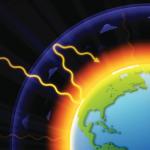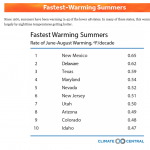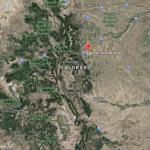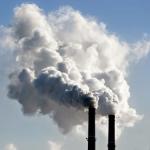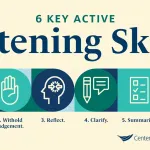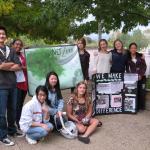Lesson Plans & Activities
Ice Core Demonstration: The Past is the Key to the Future
Project EXTREMES lessons were written to be stand alone lessons but can be incorporated into a larger unit.
This lesson has students explore how the gases trapped in ice cores over the last quarter of a century can be used to understand how Earth's atmosphere has changed in the past.

What’s Up With The Rising Temperatures in Colorado Cities?
This is the first lesson in the Climate Resiliency Education Middle School Climate Unit.
This lesson introduces why certain cities in Colorado are getting hotter using a video by the Denver Post that describes the pattern.
What Was Earth’s Temperature Like in the Past?
This is the fifth lesson in the Climate Resiliency Education Middle School Climate Unit.
Students examine what the world’s temperature trend was in the past and whether temperatures have changed recently.
How Does Human Activity Affect the Warming Temperatures on Earth?
This is the sixth lesson in the Climate Resiliency Education Middle School Climate Unit.
This lesson explores whether human activities release greenhouse gases, like CO2, and whether these activities can cause temperatures on Earth to increase.
How Does an Increase in CO2 Cause an Increase in Temperature?
This is the eighth and final lesson in the Climate Resiliency Education Middle School Climate Unit.
In this lesson, students learn how more CO2 in the atmosphere causes global warming.Why Are Cities Getting Hotter?
This is the first lesson in the Climate Resiliency Education High School Climate Unit.
During this lesson, students explore the increase in summer temperatures and describe the pattern as it relates to Colorado using a video by the Denver Post.
What is Special About Cities Compared to Rural Places?
This is the second lesson in the Climate Resiliency Education High School Climate Unit.
This lesson explores climate data at local, national, and global levels to determine that temperatures are changing all over the world, and that there are certain locations where temperatures are warming faster than the global average.
Why Are Cities and Other Regions of the World Getting Hotter?
This is the third lesson in the Climate Resiliency Education High School Climate Unit.
This lesson has students investigate how albedo is contributing to temperature increasing in some places, like cities, are increasing at faster rates than elsewhere.
How Do Humans Contribute to the Increase in Global Temperatures?
This is the fourth lesson in the Climate Resiliency Education High School Climate Unit.
Students explore the greenhouse effect in this lesson using a computer simulation and develop a model for how it works.
Is it Normal That World Temperatures Are Rising This Fast?
This is the fifth lesson in the Climate Resiliency Education High School Climate Unit.
This lesson explores if it is normal that world temperatures are rising at the currently observed fast pace.
Photosynthesis, Respiration, and the Short-Term Carbon Cycle
Project EXTREMES lessons were written to be stand alone lessons but can be incorporated into a larger unit.
This lesson is focused on the short-term cycling of carbon and is designed to put the processes of photosynthesis and respiration within a global perspective.

Data Puzzle: On a Budget
This data puzzle is a stand-alone lesson that is part of a larger collection of data puzzles.
The Arctic is currently warming at a rate faster than the global average, a phenomenon known as Arctic amplification. In this Data Puzzle, students analyze authentic Arctic datasets to construct explanatory models for the following question, "Why might the Arctic be warming faster than other places on Earth?"
Data Puzzle: Balancing Act
This data puzzle is a stand-alone lesson that is part of a larger collection of data puzzles.
Since the early 2000s, the Greenland Ice Sheet’s mass balance has been consistently negative, meaning more mass is being lost than gained. But this change in mass balance hasn’t always happened at the same rate. What could account for observed changes to the amount of ice in the Greenland Ice Sheet in recent decades?
Active Listening Skills
This activity is one of seven activities in the Climate Mental Health Support Activities.
In this lesson, students will identify emotions they experience as they learn about the impacts of climate change. In pairs, students will practice active listening skills as one student describes their emotions to the partner who applies active listening skills. They then flip roles and the other student describes their emotions while the partner listens.
Facilitating Discussions and Creating Solidarity
This activity is one of seven activities in the Climate Mental Health Support Activities.
Talking about emotions related to climate change can help youth to process emotions, move on, and develop trust and connection with others through shared solidarity. In this lesson, students will discuss their thoughts and feelings about climate change with others. Consider teaching the Emotions Wheel and Active Listening activities before this in order to help students develop language and discussion skills.




